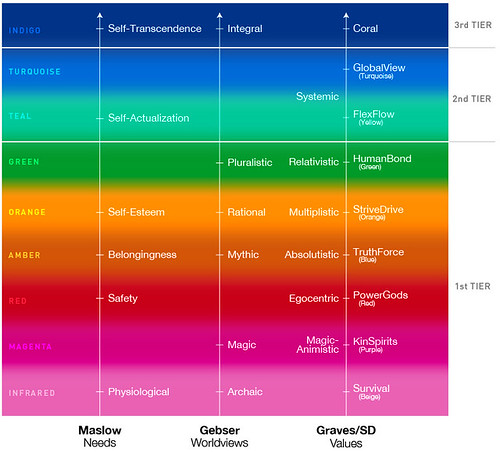 Over at Keith Rice's site, Sociopsychologist, he lays out what feels to me like a preliminary look at finding neural correlates for the developmental values memes (vMEMES) in the Clare Graves, Beck & Cowan model of Spiral Dynamics.
Over at Keith Rice's site, Sociopsychologist, he lays out what feels to me like a preliminary look at finding neural correlates for the developmental values memes (vMEMES) in the Clare Graves, Beck & Cowan model of Spiral Dynamics.Although it's a good first effort, there are only brain regions suggested and not specific structures. He hints at some better detail (in the work of Joseph LeDoux, for example), but he also derails his project by using Freud's concepts of id, ego, and superego - something most psychoanalytically trained folks don't even do these days.
I would propose that there is much to be gleaned from the work of interpersonal neurobiology (especially the brilliant work of Allan Schore, which is psychoanalytically based, in the neuroscience of attachment affect regulation [a major component of the development of the self]), especially regarding the more communal memes. Likewise, I suspect there is much to learn from the work of Antonio Damasio about how the "self" is created in the brain, and how that applies to the more individualistic memes. That is only for starters.
I would also look at work by Jaak Panksepp, Rodolfo Llinás, Vilayanur S. Ramachandran, Merlin Donald, Gerald Edelman, Francisco Varela, Steven Rose, Michael Gazzaniga, Robert Sapolsky, and so many others. I would also look at people like Jerome Bruner, Geroge Lakoff, Kenneth Gergen, and other people working in language and interpersonal realms.
Anyway, here is the beginning of Rice's post.
A Biological Basis for vMEMES?
vMEMES, the motivational systems identified in Spiral Dynamics, clearly have to have a neurological basis. Whatever your views on Dualism and the Mind-Body Debate -whether or not we think there is a ‘mind’ or ‘soul’ distinct from the brain - the motivational effect we recognise as the work of what we call a ‘vMEME’ has to have a concomitant pattern of neurological activity.
So where is it? Or: where are they...the 8 vMEMES identified so far from the work of Clare W Graves, that is?
According to Spiral Dynamics co-
developer Don Beck (Wright Foundation, 2009) a project has been launched with the Brain Research Laboratory at the University of Cologne to track the neurology of the vMEME systems. Until Cologne’s Brain Research Laboratory publish their findings, just how vMEMES operate in the brain will remain a mystery...or will it?
In fact, by some judicious mapping of existing neuroscience, it is possible to build a picture of how 1st Tier vMEMES might work in the brain. 2nd Tier systems appear to be decidedly more tricky.
1st Tier vMEMES and Sigmund Freud
In our quest to track how vMEMES might function neurologically, we need to consider the work of arguably the single most influential psychologist ever, Sigmund Freud. It is possible to create a rough match between Freud’s structure of the mind (based on observation and reflection) and that of Graves (based on arduous research).
Read the whole article.
2 comments:
Thanks for posting this! Having been Graves' student at Union many years ago, and having done an early piece of research on his work, I've had some concerns about how his ideas have been altered and utilized over the years. One thing some subsequent thinking fails to recognize is the role of socio-economic and cultural forces in "evolving" the mind/body system, Also, consciousness cannot be accounted for by any neurological processes. Concomitant is not causal! I think Graves would be taken aback, some, by how his thinking has been promoted in some quarters. Also, the "research" wasn't as "researchy" as some think! He developed ideas and insights from a number of sources, over the years, which fed into his provocative formulations.
Thanks for your thoughts, Doug.
I've always thought that Beck and Cowan have done a good job of stressing the influence of life conditions - socio-economic and socio-cultural stuff - in developing up the Spiral. Not so much from Wilber, although he used to be better at talking about how people generally can't move more than .5 of a stage from where their parents and/or the cultural norm is. Made sense.
And I agree that part of the problem is that Graves intuited a lot from limited data, and no one has really done the extensive research necessary to validate the constructs, or show that they are reliable across cultures and generations.
Much still to be all around.
Post a Comment